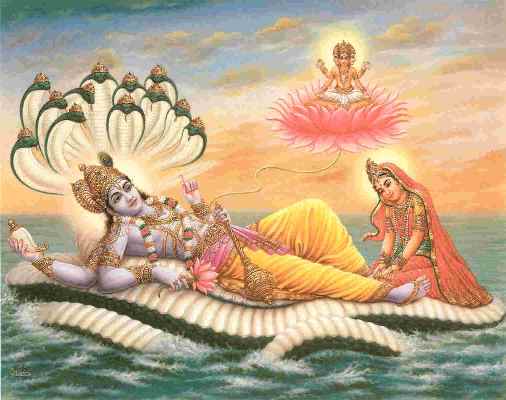
1. Science behind the idol
Idols of Vishnu can be traced from the 2nd to the 8th century.
1 A. Instruments, ornaments, the family and their scientific meaning
| Part of the body / family | Instrument / ornament | Name | Complexion | Mission / implied meaning |
|---|---|---|---|---|
| 1. Head | Crown | Kutastha | – | Sattva |
| 2. Ears | Earrings | – | – | The perishable (kshar) and imperishable (akshar) principles |
| 3. Neck | Garland of flowers | Vaijayanti* | Five colours | The Primal Energy (Adya), the Invincible Energy (Ajayashakti) |
| 4. Chest | ||||
| A. | Footprint of His devotee | – | Flowers of a tuber | Love for devotees |
| B. | Diamond | Koustubh | Red | Radiance |
| 5. Hand | ||||
| A. 1. | Conch | Payanchajanya | Of the full moon | Brahman in the form of a word present in the five cosmic elements or the commencement of a war |
| 2. | The posture assuring protection (abhaymudra) | Blessing | ||
| B. | Discus** | Sudarshan | Of a thousand suns | The weapon which can be flung or operated from a distance |
| C. | Mace (placed near the right foot) | Koumodaki | Of Krushna (dark) | The weapon used when the enemy is close, the Primal Knowledge (Adividya), the form of the universal intellect (Mahat principle), the energy destroying ego |
| D. | Padma (lotus) | – | – | Procreation, creation, Serenity (shanti). |
| E. | Bow | Sharanhga | – | The Primal Illusion (Adimaya) |
| 6. Family | ||||
| A. Wife | – | Lakshmi*** | Golden | Divine Energy (Shakti) |
| Wife | – | Pushti | Of the Shirish flower | Divine Energy (Shakti) |
| B. Serpent | – | Anant | Of a cloud | Pure particles |
| C. Vehicle | – | Garud | Of a lotus | Vehicle |
* An energy. Vaijayanti (वैजयंती) = vai (वै) + jayanti (जयंती). Vai means numerous eras (yugs) and jayanti means chains. The one adorning the necklace of Vaijayanti is the one wearing the chains of the eras around His neck and the one beyond time, that is Lord Vishnu.
** The rotating discus is the Great Illusion. The finger about which it rotates is stationary and represents Brahman. Information on the discus (sudarshan) is given in ‘How did Lord Krushna acquire Sudarshan Chakra?’.
*** The Divine Energy which is constantly engaged in destroying the mind and distressing energy. Lakshmi is seated at His feet. [Parvati is seated on Shiva’s lap. Shiva – Parvati seated together imply the dissolution of duality, that is the state of non-duality (advait).]
1 B. Sheshashayi Vishnu (Padmanabh)
One of the famous forms of Vishnu is that of Sheshashayi Vishnu wherein He reclines on the serpent named Shesh. Lakshmi is seated at His feet. There is a lotus emerging from His navel. Lord Brahma is seated on the lotus and the earth is supported on Shesh’s head. Such is the form of Sheshashayi Vishnu. The implied meaning of this form is as follows.
-
Shesh : Shesh means the reserve or remnant. After subtraction of one number from another the result is the remainder. When a particle starts disintegrating, that particle which is the most subtle and which cannot disintegrate further means the core of the paramanu (atom), is called Shesh. The three most subtle particles in it are dhan (proton), run (electron) and udasin (neutron). [Shesh can absorb the 108 (narayan) frequencies coming from the region of the stars (nakshatralok) and can also bring about changes in them.]
-
The earth : The earth is made up of minute particles. The existence of every particle is dependent on the serpent (Shesh) within its core. The earth is held on Shesh’s head implies that Shesh is supporting the earth.
-
Vishnu : Vishnu is the radiance from the dhan, run and udasin frequencies from Shesh.
-
Lakshmi : If Vishnu is the form of dhan frequencies then Lakshmi is that of run frequencies. In other words the feminine form of Vishnu is Lakshmi.
-
The lotus : The lotus is a symbol of creation. The energy which emanates from Vishnu’s navel, that is from the Para mode of speech is depicted as a lotus. This energy of creation is not derived from Vishnu alone but from the union of Vishnu and Lakshmi. Vishnu is also named Padmanabh due to the lotus (padma) which springs from His navel (nabhi).
The Sahasrar chakra, the last in the Path of Activation of Spiritual Energy (Kundaliniyoga) is also called Sahasradal. The lotus in Lord Vishnu’s hand symbolises that He can endow the highest spiritual experience from the Path of Yoga.
-
Lord Brahma : The spiritual experience arising from the lotus, that is from the energy of creation is called Brahmadev or Brahma.
The twenty-four Names of Vishnu given under point ‘2. Some other Names’ differ only with respect to the order of the instruments held in the hands of the idols. Otherwise the idols are the same.
Reference : Sanatan Sanstha’s Holy text ‘Vishnu and His forms’

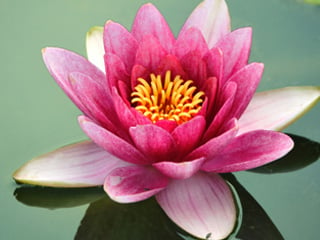
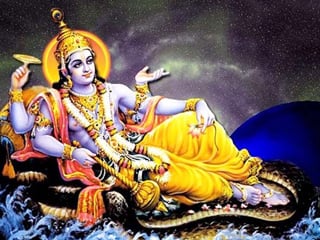 What are the implied meanings of the ten incarnations of Lord Vishnu ?
What are the implied meanings of the ten incarnations of Lord Vishnu ?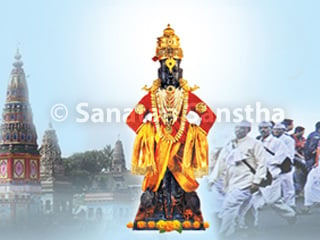 What does the idol of Lord Vitthal with His hands on the waist signify?
What does the idol of Lord Vitthal with His hands on the waist signify?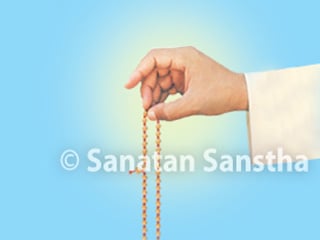 Why should one chant specific Lord Vishnu mantra for accomplishing a particular mission?
Why should one chant specific Lord Vishnu mantra for accomplishing a particular mission?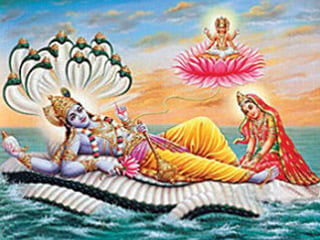 Why is Lord Vishnu called as foremost Guru?
Why is Lord Vishnu called as foremost Guru?